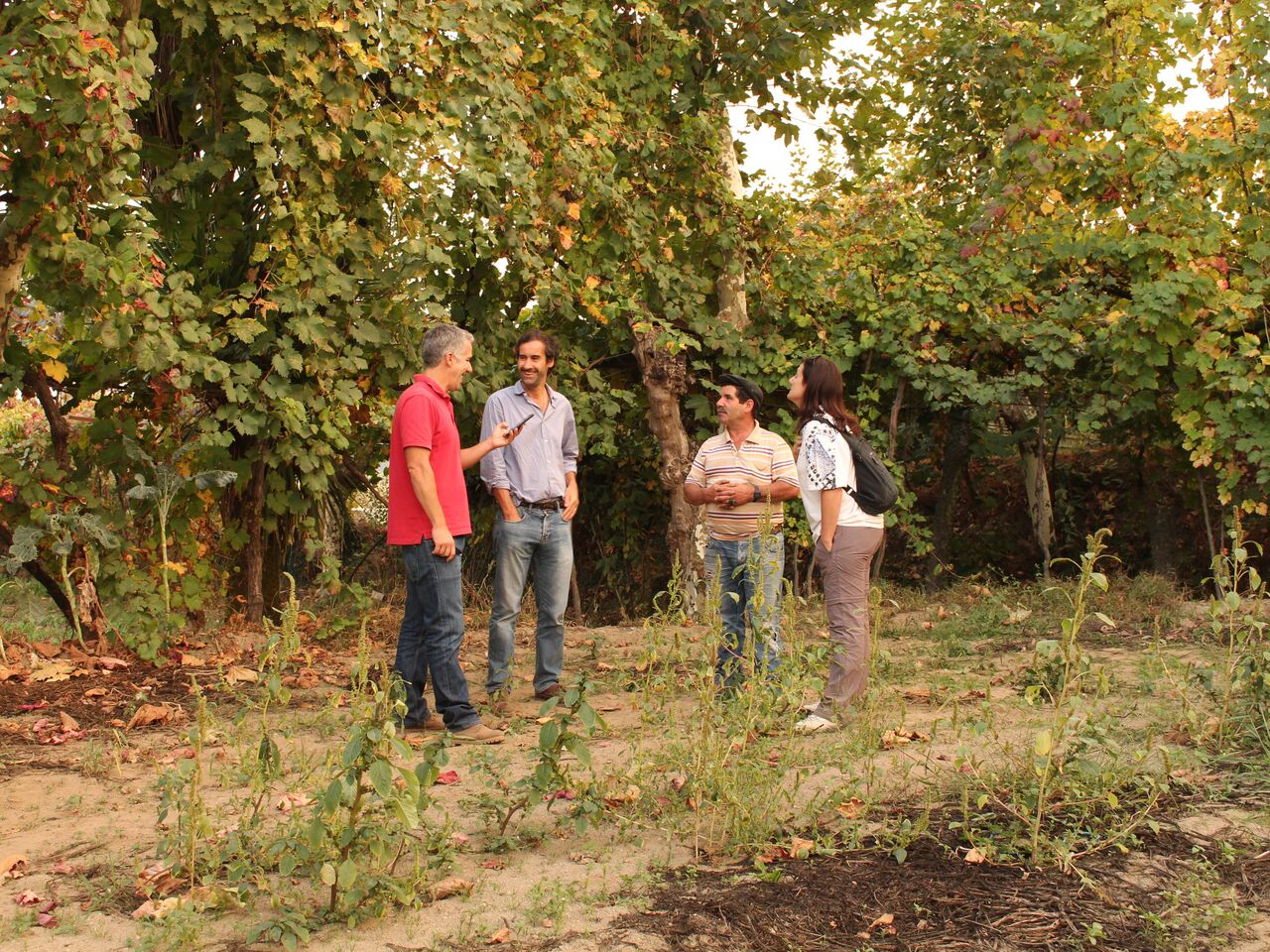Agroforestry is a long known practice in Portugal, characterized by distinct systems, including a variety of species, cultures and local varieties and breads of animals and crops. In central and northern regions of the country, characterized by small to medium size farms, agroforestry was for many centuries the basis of family agriculture, allowing families to increase the diversity of products produced by area of land.
|
Fig. 1 Engraving from a traditional ‘vinha do enforcado’. |
In the Portuguese Northern region, one traditional system originated from the middle age persists, although with an alarming decreasing area: the ‘hanged vineyard’ (‘vinha do enforcado’) (Fig. 1). The system is based on the production of grapes for wine production, cultivated around the limits of the farm arable plots, deliberately managed in a vertical position (reaching 4m or more) with the support of trees such has Platanus spp, Celtis australis, Fraxinus spp, Populus spp, Ulmus spp etc. Inside the plots, arable crops production or pastoral activities are carried out. In this system, trees are pruned annually in order to achieve two distinct goals: supply of tree fodder to animals in the farm and reduction of tree shading of the vineyard that ultimately, if not carried out, would restricts the fruit (grapes) development and maturation. For this reason, tree species known to be suitable for coppicing practices are the ones selected for this purpose. |
 |
| FIg. 2 AFINET visit promotors, farmer and Portuguese Innovation Broker |
 |
| Fig. 3 ‘Vinha do enforcado’ agroforestry system: trees (Platanus spp. in this case) serving as poles for vertical vineyard development |
The plant varieties used in the ‘vinha do enforcado’ present distinct characteristics when compared to other vineyards: i) high predominance of vertical growth; ii) high tolerance to shadow; iii) distinct organoleptic properties of the grapes. These varieties and management specificities, both now endangered, originate a unique type of wine, with specific properties, that has still not been fully studied and is hardly considered for the wine industry.
Currently this system is clearly endangered due to the intensification of intensive vineyards production and the decreasing labor availability. A few hectares of these systems remain in the region of Vale do Sousa and surrounding areas. In October 2017 the AFINET project payed a visit to one of the last farms producing wine from ‘vinha do enforcado’ in Vale do Sousa. The visit was promoted by Associação de Desenvolvimento Rural das Terras do Sousa, a local rural development association, member of the PT RAIN, and by the local wine cooperative Terras de Felgueiras – Caves Felgueiras, CRL (Fig. 2). The visited farmer has 2.5 ha of owned land and some more rented area. His farm is composed of 1 ha of ‘vinha do enforcado’ (Fig. 3 and 4), with maize production inside those plots, 1.7 ha of modern (horizontal) vineyards and 50 ‘Limousine’ cows. In addition to the description of the farming system, the visit also aimed at understanding the motives for the abandonment of this kind of practice, where four main reasons were identified:
- Lack of manpower for the grapes harvesting: this activity is still practiced manually, using tall ladders, representing a dangerous and time consuming activity;
- Expensive maintenance and grape harvesting practices;
- Low price of the grapes in the wine production sector;
- The CAP specific programme for restructuring and conversion of vineyards (VITIS –Portuguese national programme) that covers the change in management systems and varietal reconversion. In the Entre-Douro-e-Minho region (northwestern region of Portugal), the removal of one square meter of ‘vinha do enforcado’ vineyard installed in the border gives rise to a planting permit of three square meters of continuous vineyard.
Urgent action for this traditional vineyard agroforestry system protection and support is needed. It represents an opportunity for the development of new products and services in this region: (1) there’s the clear possibility for a new product establishment, given that these grape varieties tend to produce wines slightly more acidic and with lower alcohol content, creating less intoxicating wines; (2) its contribution for the local biodiversity, probably holding some specific fauna (birds and bats), must be accountable; (3) by being an ancient traditional practice, maybe an application to UNESCO World Heritage should take place, contributing for the development of regional tourism.
The AFINET project wants to call the attention on these endangered agroforestry systems, showcasing these examples and fostering European community action.
 |
|
| Fig. 4 Detail of ‘vinha do enforcado’ layers: Platanus spp. as poles, vines and, at the moment of the visit, cabbages developing underneath. In the center of the plot usually there’s also the production of maize for animal feed. |












